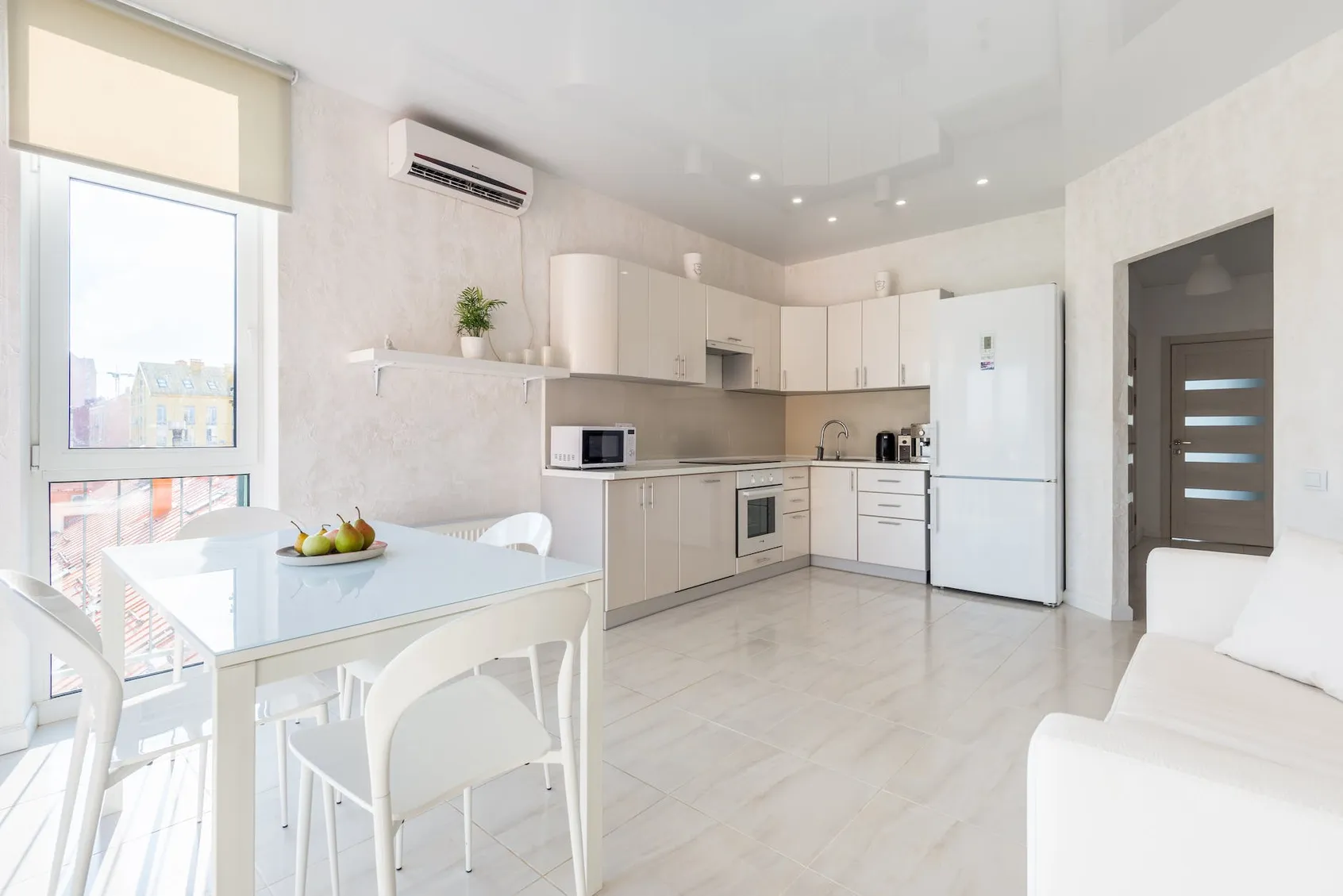Venting a kitchen exhaust fan outside is an important part of any kitchen ventilation system.
Not only does it help to reduce moisture and odors from the kitchen, but it also helps to prevent the buildup of grease and other particles that can potentially start a fire. Venting the fan outside also helps keep the kitchen air clean and fresh. So, why do kitchen exhaust fans need to be vented outside?
In this article, we will discuss the basics of venting kitchen exhaust fans outside, including the types of venting available, the process of installation, and the safety measures to take.
Do Kitchen Exhaust Fans Need To Be Vented Outside?
When it comes to your kitchen, it is important to properly ventilate the area to maintain a healthy and comfortable environment for cooking. One of the best ways to do this is to install a kitchen exhaust fan and vent it outside. There are a few different options for venting kitchen exhaust fans outside, each with advantages and disadvantages.
The most common option is to use a ducted range hood. This type of hood vents air outside through a duct system. The advantage of using a ducted range hood is that it can provide maximum airflow and effective ventilation. It is also the most efficient way to vent kitchen exhaust fans outside. The downside of a ducted range hood is that it requires installation and can be expensive.
Another option for venting kitchen exhaust fans outside is to use a non-ducted range hood. This hood vents air outside through a filter rather than a duct system. The advantage of using a non-ducted range hood is that it is easy to install and much less expensive than a ducted range hood. The downside of a non-ducted range hood is that it may be less efficient in ventilating the kitchen and can be noisy.
Opt for a wall-mounted vent hood if you don’t want to install a kitchen exhaust fan. This type of hood vents air outside through a side wall of the kitchen. The advantage of a wall-mounted vent hood is that it takes up less space and is easier to install than a ducted or non-ducted range hood. The downside is that it does not provide as much airflow as other options and can be noisy.
No matter which option you choose, ensuring the kitchen exhaust fan is properly vented outside is important. This will ensure that your kitchen remains a healthy and comfortable environment for cooking.

Types Of Exhaust Fans
Several types of exhaust fans are available on the market, each with unique features and benefits. Here are some of the most common types of exhaust fans:
- Wall-mounted exhaust fans: These are mounted on an exterior wall and are ideal for limited-space kitchens. They are easy to install and available in various sizes and styles.
- Island range hoods: These are mounted above a cooktop on an island in the middle of the kitchen. They are designed to be a central focal point in the kitchen and come in various styles and sizes.
- Under-cabinet range hoods: These are mounted under the cabinets above the cooktop and are ideal for limited-space kitchens. They are available in different sizes and styles to fit your kitchen décor.
- Downdraft range hoods: These are built into the cooktop and pull smoke and steam down through the vents and out of the kitchen. They are ideal for kitchens that don’t have space for an overhead exhaust fan.
- Ceiling-mounted exhaust fans: These are mounted on the ceiling and are ideal for large or commercial kitchens. They are available in various sizes and styles to fit your needs.
Benefits Of Venting Kitchen Exhaust Fans Outside
There are several benefits to venting kitchen exhaust fans outside rather than into the house’s kitchen or other living spaces. Here are a few reasons why outside venting is a more effective and healthier option:
- Improved air quality: When kitchen exhaust fans are vented outside, they can effectively remove smoke, steam, and other pollutants from the air, preventing them from circulating back into the kitchen or other living spaces. This is especially important for those with respiratory issues or allergies.
- Reduced moisture and humidity: Cooking produces a lot of moisture and humidity, which can lead to mold and mildew growth if not properly ventilated. Venting kitchen exhaust fans outside can help reduce moisture and humidity, preventing mold and other moisture-related problems.
- Increased energy efficiency: When kitchen exhaust fans are vented inside the house, they can cause a negative pressure that pulls in hot or cold air from the outside, making your HVAC system work harder to maintain a comfortable temperature. Venting outside helps prevent this, improving energy efficiency and lowering utility bills.
- Improved comfort: Venting kitchen exhaust fans outside can also help improve the overall comfort of your home by removing excess heat and odors from the kitchen, making it a more pleasant place to cook and spend time in.
How To Vent A Kitchen Exhaust Fan Outside?
It is essential to ensure that your kitchen exhaust fan is properly vented outside to prevent any health risks from a buildup of moisture, carbon monoxide, or other potential hazards. Several steps should be taken to safely and correctly vent a range hood outside.
- Measure the area around the exterior wall where the range hood will vent. You should measure the distance between the range hood and the wall and the circumference of the wall itself. This will help you determine the size of the venting duct you must purchase. Ensuring the duct is large enough to vent the range hood properly is important.
- Cut the hole in the exterior wall for the venting duct. This hole should be slightly larger than the size of the venting duct, as this will allow for easier installation. You should also ensure the hole is properly insulated to prevent air leakage.
- Install the venting duct. You should ensure the duct is properly sealed around the edges to prevent air leakage. You should also ensure the duct is securely fastened to the exterior wall.
- Connect the range hood to the venting duct. You should ensure the connection is securely fastened to prevent any air leakage.
- Test the venting system. You should turn on the range hood and ensure the air is properly venting outside. If the venting system is functioning properly, you should feel a slight breeze from the venting duct. If you do not feel any breeze, it may indicate that the venting system is not properly installed or that there is an issue with the duct.
Safety Tips For Exhaust Fan Venting
When it comes to venting kitchen exhaust fans outside, safety should always be your top priority. Here are some key safety tips you should follow when venting kitchen exhaust fans outside:
- Ensure proper installation: Ensure the exhaust fan is installed correctly and securely. It could fall or become a safety hazard if it’s not properly installed.
- Check for proper wiring: It’s important to ensure the exhaust fan wiring is up to code and properly grounded to avoid any electrical hazards.
- Use the correct size duct: Using the right size for your exhaust fan is important to ensure proper ventilation and prevent damage to the fan motor.
- Regular maintenance: Regularly clean the exhaust fan to prevent any blockages that could lead to a fire hazard.
- Avoid using extension cords: Using extension cords with exhaust fans can be dangerous and increase the fire risk. It’s best to have a professional electrician install an outlet near the exhaust fan for safe and convenient use.
Installation Of Exhaust Fans
Installing exhaust fans can be a great way to improve air circulation and reduce humidity in certain areas of your home or business. Here are a few tips for getting started with the installation process:
- Determine the location of the exhaust fan. Ideally, you’ll want to install the fan in a location with an opening to the outside, such as a bathroom or kitchen ceiling.
- Choose the right size fan for the space. Choosing an appropriately sized fan for the area you want to ventilate is important. A fan that is too small won’t be effective, while a fan that is too large may be unnecessarily loud or use more energy than needed.
- Install the fan according to the manufacturer’s instructions. This may involve cutting a hole in the ceiling or wall, wiring the fan to an electrical source, and attaching the fan to the opening.
- Use ductwork to vent the exhaust outside. It’s important to ensure that the exhaust from the fan is properly vented to the outside of the building rather than simply being released into an attic or other enclosed space.

Maintenance Of Exhaust Fans
Maintenance of exhaust fans is important to ensure that they continue to function effectively and efficiently. Here are some tips for maintaining your exhaust fans:
- Clean the fan blades regularly to remove any dirt or debris that may have accumulated on them. This will help prevent the blades from becoming imbalanced or clogged, which can affect the fan’s performance.
- Check the motor and bearings periodically to ensure that they are running smoothly. If you notice any unusual noises or vibrations, it may be a sign that the motor or bearings need to be lubricated or replaced.
- Replace the filters regularly to ensure the fan effectively removes contaminants from the air. This is especially important in areas with dust or other airborne particles.
- Inspect the ductwork periodically to ensure it is properly sealed and free of any obstructions. This will help ensure that the fan can move air efficiently and effectively.
Local Building Codes For Exhaust Fan Venting
Local building codes for exhaust fan venting can vary depending on your location, so it’s important to check with your local building department for specific regulations. However, here are some general guidelines that may apply:
- Exhaust fans should be vented outside, not into an attic or crawl space.
- Vent pipes must be made of appropriate materials, such as galvanized steel or PVC.
- Vent pipes must be securely attached to the exhaust fan and the exterior vent hood.
- Exterior vent hoods must have a damper to prevent backdrafts.
- Vent hoods should be located at least 3 feet away from any windows or doors that could let the exhaust back in.
- The size of the vent pipe should be appropriate for the size of the exhaust fan.
- To ensure proper airflow, the vent pipe should be as straight as possible, with minimal bends or turns.
Different Exhaust Fan Accessories
Several exhaust fan accessories are available in the market that can enhance the performance and functionality of your exhaust fan. Here are a few of them:
- Ducting: This accessory helps direct the airflow from the exhaust fan to the desired location. Ducting also helps in reducing noise and vibration caused by the fan.
- Grilles and Covers: Grilles and covers protect the exhaust fan from dust, dirt, and other debris that can damage the fan blades. These also help to improve the aesthetics of the fan.
- Speed Control: This accessory allows you to adjust the speed of the exhaust fan according to your needs. It helps in reducing energy consumption and noise levels.
- Ventilation Timer: A ventilation timer helps automate the operation of the exhaust fan. It turns the fan on and off at pre-set times, ensuring the room is well-ventilated even when you are not present.
- Humidity Sensor: A humidity sensor is useful for exhaust fans in bathrooms or laundry rooms. It automatically turns the fan on and off based on the humidity level in the room.
Considerations When Choosing An Exhaust Fan
When choosing an exhaust fan, several factors must be considered to ensure you select the best one for your needs. Here are a few considerations to keep in mind:
- Ventilation requirements: Determine the space size you need to ventilate and the minimum airflow rate required to remove moisture or fumes adequately.
- Noise level: Consider the noise level of the exhaust fan, especially if it will be installed in a living area or near bedrooms where excessive noise could be disruptive.
- Energy efficiency: Look for an exhaust fan that is energy efficient, as this can help reduce your electricity bills.
- Durability: Choose an exhaust fan made from quality materials that can withstand the rigors of regular use and exposure to moisture or fumes.
- Installation: Ensure the exhaust fan is easily installed and fits your specific installation requirements.
Cost Of Installing An Exhaust Fan Outside
Installing an exhaust fan outside is a great way to eliminate unwanted odors, smoke, and moisture from the kitchen. However, it can be a costly endeavor, depending on the type of fan you choose and the complexity of the installation.
The fan cost may range anywhere from $50-$300, depending on the size and type of fan. The installation cost can also be quite expensive, depending on the job’s complexity.
Installation costs may range anywhere from $200-$800. This cost usually includes the labor charges, materials, and any additional parts needed for the installation.
In addition to the cost of the fan and installation, there may be other additional costs that you need to consider. These costs may include hiring an electrician to connect the fan to the existing wiring or extra ductwork needed for the installation.
You may also need to purchase a mounting bracket or other hardware for the fan. Finally, you may need to factor in the cost of any permits or inspections required for the installation.

How To Vent Range Hood Outside?
Venting a range hood is important in properly installing an exhaust fan in the kitchen. Without proper ventilation, the fan cannot efficiently remove smoke and odors from the kitchen, which can create a hazardous environment. Proper ventilation is also necessary to keep the fan from creating a fire risk. The following steps outline how to vent a kitchen range hood outside.
First, check to ensure the fan is appropriate for use outdoors. Not all exhaust fans are built to be used outside, so make sure the fan you use is approved for venting outside. Next, determine the best location for the fan to vent. The most common spots to vent an exhaust fan outside are through the roof or an exterior wall.
Once you have found the best location for the fan, you will need to install the venting materials. Start by measuring the circumference of the fan’s exhaust port. This will help you determine the correct size of the needed venting materials. Measure the length of the venting duct from the fan to the outside wall or roof.
Cut the venting materials to the correct size, then secure them to the fan with screws. Install the venting material from the fan to the wall or roof, ensuring air flow freely through the duct. Seal any gaps with caulk or other air-sealing material.
Finally, install the vent cap on the outside wall or roof. Ensure that the vent cap is securely attached and that the air can flow out of the vent freely. Once everything is installed, turn on the fan and ensure it runs properly.
Do You Need A Vent Hood For An Electric Stove?
Do you need a vent hood for an electric stove? The answer is yes. Venting kitchen exhaust fans outside is important to maintaining good indoor air quality and avoiding problems such as mold and mildew.
While electric stoves do not produce as much heat and moisture as gas stoves, they must be properly vented to remove grease, odors, and smoke. An appropriate vent hood should be installed above the stove to capture and exhaust the air from the kitchen.
Vent hoods come in various styles and sizes to accommodate different types of kitchen exhaust fans.
Wall-mounted vent hoods are typically installed above the stove and are designed to efficiently capture and exhaust grease, smoke, and odors from the kitchen.
Island vent hoods are suspended from the ceiling and are usually used in larger kitchens that may have multiple cooking surfaces.
In addition, downdraft vent hoods are typically installed at the rear of the stove and use a fan to remove air from the kitchen.
Dangers Of Cooking Without Ventilation
Cooking without proper ventilation can pose several dangers, including:
- Poor air quality: Cooking produces a lot of smoke, steam, and harmful gases like carbon monoxide. If this air is not properly ventilated, it can lead to poor indoor air quality, harming your health.
- Fire hazards: Cooking without proper ventilation increases the risk of fire hazards, especially if cooking with high heat or using flammable cooking oils.
- Increased humidity: Cooking without ventilation can cause excess humidity in your home, leading to mold growth, structural damage, and health problems.
- Unpleasant odors: Cooking without adequate ventilation can cause unpleasant odors to linger in your home, which can be unpleasant for you and your guests.
Range Hood Ventilation Requirements
A range hood is an essential appliance in any kitchen, and it is important to ensure it is properly ventilated. The ventilation requirements for your range hood will depend on several factors, including the size and type of your kitchen and the type of range hood you have installed.
Generally speaking, the range hood should be vented to the exterior of your home rather than recirculating the air back into the kitchen. This is because venting to the exterior will help remove smoke, steam, and other cooking byproducts from the kitchen, while recirculating them will simply filter them out and release them back into the air.
The size of the range hood and the fan it uses will also play a role in the ventilation requirements. A larger range hood with a more powerful fan will require a larger duct to effectively remove the air from the kitchen.
Ultimately, it is important to consult a professional installer or contractor to determine the proper ventilation requirements for your range hood. They will be able to assess your kitchen and recommend the appropriate ventilation system for your needs.
How To Vent A Range Hood On An Exterior Wall?
Venting a range hood on an exterior wall involves a few steps to ensure proper installation and functionality. Here are the steps to follow:
- Determine the location of the range hood and mark the spot on the exterior wall where the vent will be installed.
- Cut a hole in the wall according to the vent pipe size.
- Install a vent cap on the outside of the wall to prevent water and debris from entering the vent.
- Attach the vent pipe to the hood and run it through the hole in the wall, securing it with screws or clamps.
- Install a backdraft damper or vent hood transition to connect the pipe to the vent cap.
- Seal the vent cap’s edges and the pipe with caulking to ensure airtightness and prevent leaks.
Remember to consult the manufacturer’s instructions for specific installation details and codes and any applicable local regulations.
Conclusion
In conclusion, venting kitchen exhaust fans outside is an important way to keep your kitchen and home safe and healthy. It helps to eliminate odors, steam, and smoke from your kitchen, as well as any grease and grime that may accumulate. Ensure you install your exhaust fan correctly, use the right size and type of fan for your kitchen, and regularly clean and maintain it.
Frequently Asked Questions:
Do you have to vent a range hood to the outside?
Yes, venting a range hood to the outside is usually necessary to prevent the buildup of smoke and fumes in the home.
What is the code for the kitchen exhaust fan?
The kitchen exhaust fan code depends on your area’s local building codes. You should consult your local building codes for specifics.
Is it ok not to have a vent in the kitchen?
No, it is not ok not to have a vent in the kitchen. Proper ventilation is essential in the kitchen to reduce humidity and remove smoke, steam, odors, and other airborne particles. These particles can build up without proper ventilation and cause health and safety concerns.
How often should kitchen exhaust fans be vented outside?
Kitchen exhaust fans should be vented outside at least once every three months to ensure they function properly and remove any built-up grease and dirt.
What are the safety considerations for venting a kitchen exhaust fan outside?
When venting a kitchen exhaust fan outside, it’s important to consider safety measures such as installing the vent away from openings, combustible materials, and having a backdraft damper. Regular cleaning is necessary to prevent blockages and fire hazards, and compliance with building codes is also important for safe operation.
Are there any special requirements for venting kitchen exhaust fans outside?
Yes, there are special requirements for venting kitchen exhaust fans outside. These requirements vary depending on local building codes. Still, the exhaust fan should generally be vented to the outside of the building, away from any air intakes or windows, and properly sized for the kitchen space. The vent should also be designed to prevent back-drafting and sealed to prevent air leakage. Finally, the vent should be protected from weather elements like rain or snow.
What is the best way to ensure proper ventilation when venting kitchen exhaust fans outside?
The best way to ensure proper ventilation when venting kitchen exhaust fans outside is to use a flexible aluminum dryer vent hose with a back-draft damper to prevent cold air from entering the house and positive pressure from escaping. The exhaust fan should also be installed near the ceiling, higher than any other appliance, to ensure the exhaust is properly vented outside. The exhaust fan should also be properly sealed to the wall and insulated to prevent any air leakage.
